Italian Meringue Buttercream (IMBC)
Italian Meringue Buttercream (IMBC) is my favorite cake frosting. This is the exact recipe I used for 10 years in my wedding cake business.
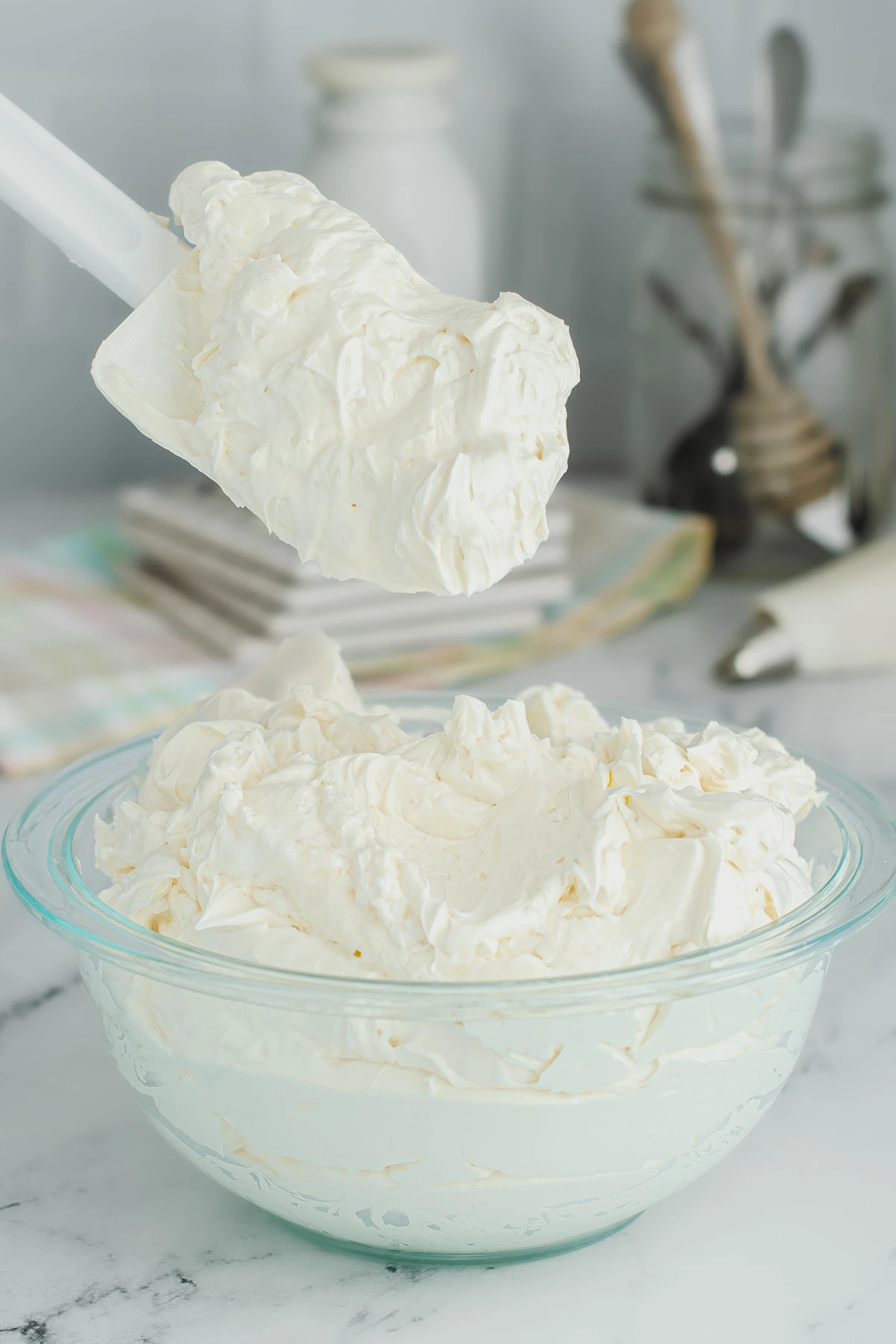
Table of contents
Why this is my favorite buttercream
Italian Meringue buttercream has the perfect balance of rich flavor from the butter, and lightness from the meringue. It’s not overly sweet and it can be flavored with an endless variety of add-ins. It’s strong enough to pipe buttercream roses and stays soft at room temperature so it melts in your mouth.
Ingredients
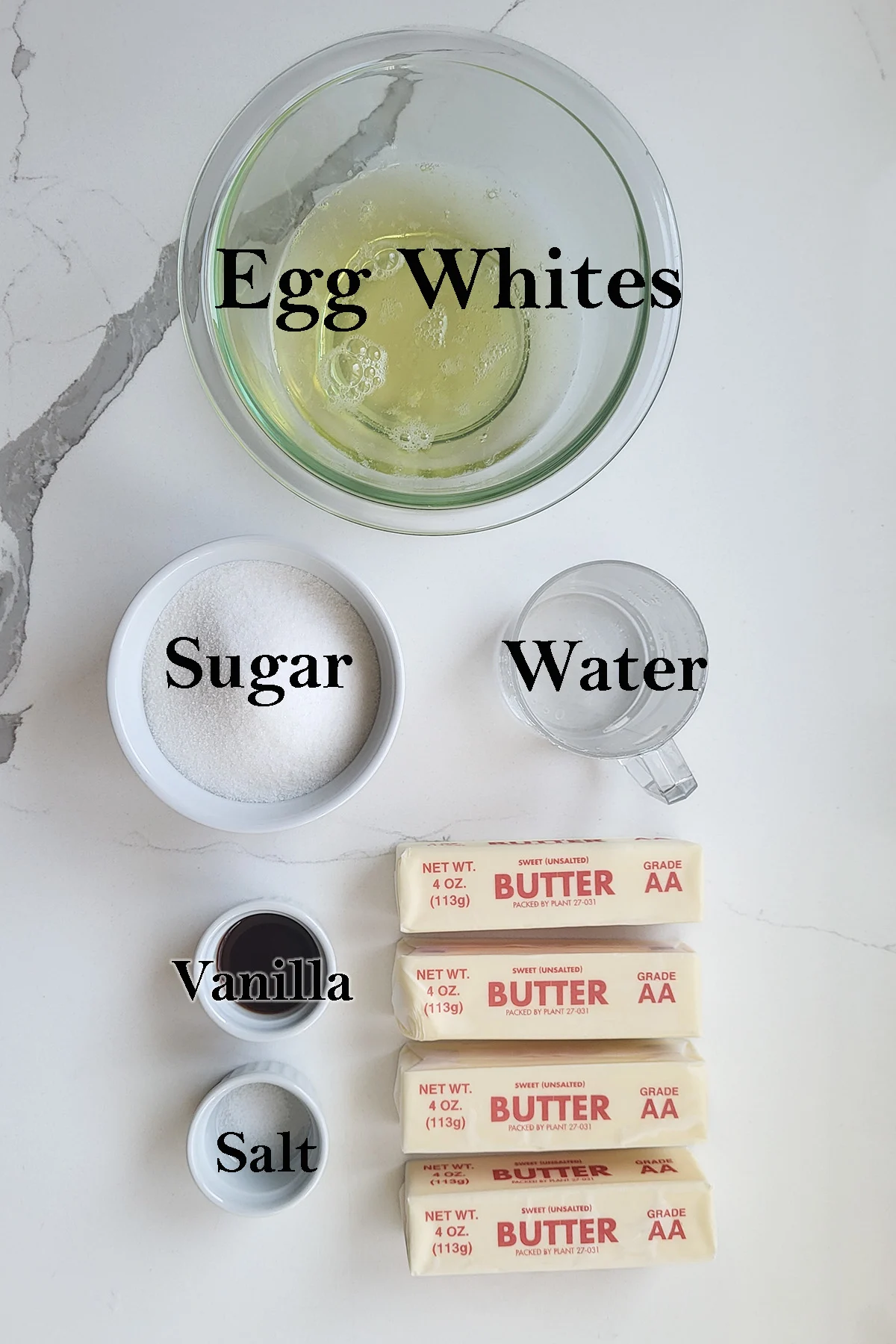
- Water – To make the sugar syrup.
- Granulated sugar – Added in two stages. Dry sugar starts the meringue, then sugar syrup “cooks” the meringue.
- Egg whites- Fresh or in-shell pasteurized egg whites can be used. If you use frozen egg whites read the label to be sure they can be whipped for meringue.
- Salt – Just a touch to balance out the flavor.
- Unsalted butter – Softened butter is whipped into the meringue base. Unsalted butter allows you to control the amount of salt in the recipe.
- Vanilla extract – Use natural vanilla extract for the best flavor. You can also use vanilla bean if you don’t mind the little specks.
Process Photos
See the recipe card for detailed measurements and instructions.
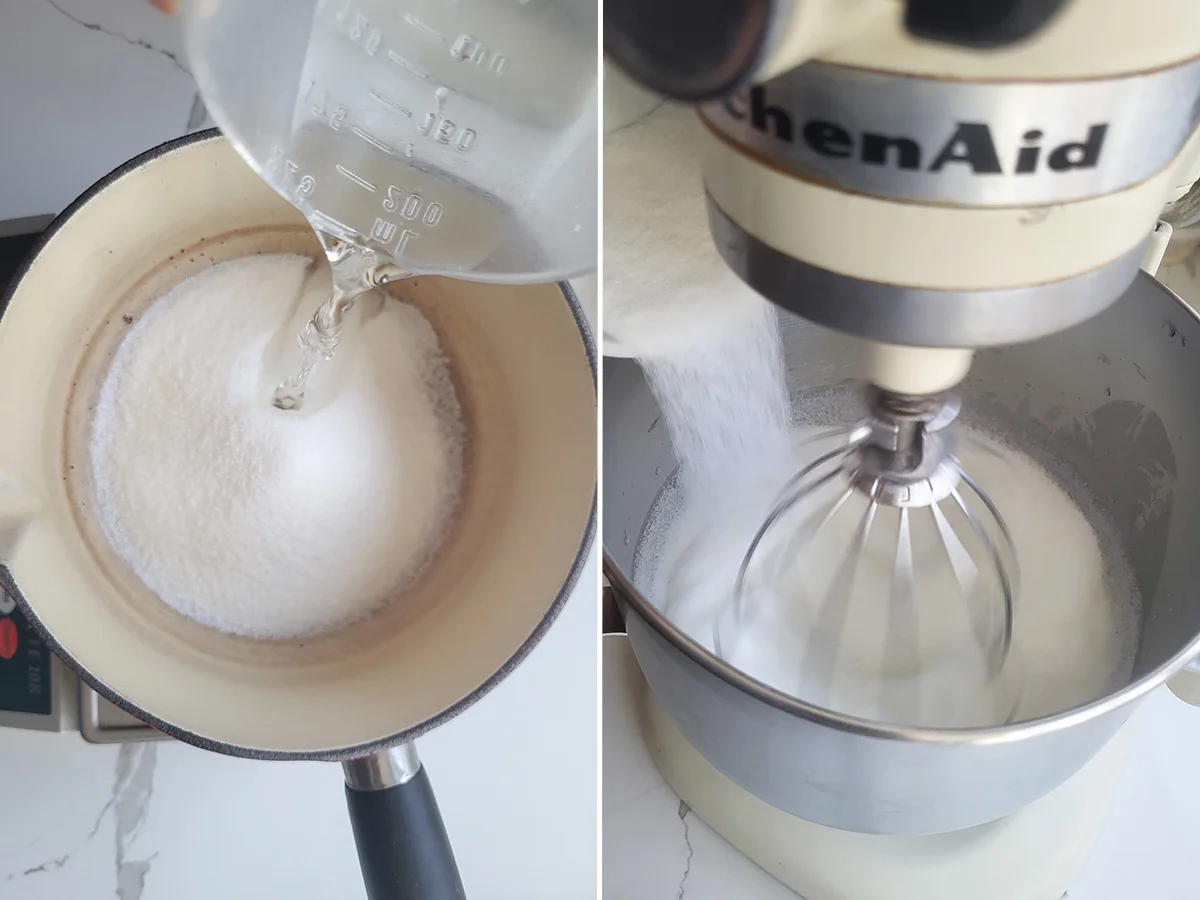
- Combine some of the sugar with water in a small saucepan. Bring the syrup to a boil.
- While the syrup cooks, whip the egg whites with the remaining sugar.

- Bring the syrup to the softball stage (235°-240°F). Immediately remove from the heat.
- With the mixer running, add the syrup in a steady stream. Try to keep the stream of syrup between the whisk and the side of the bowl.
- Whisk until the whites are cooled to about 80°F.
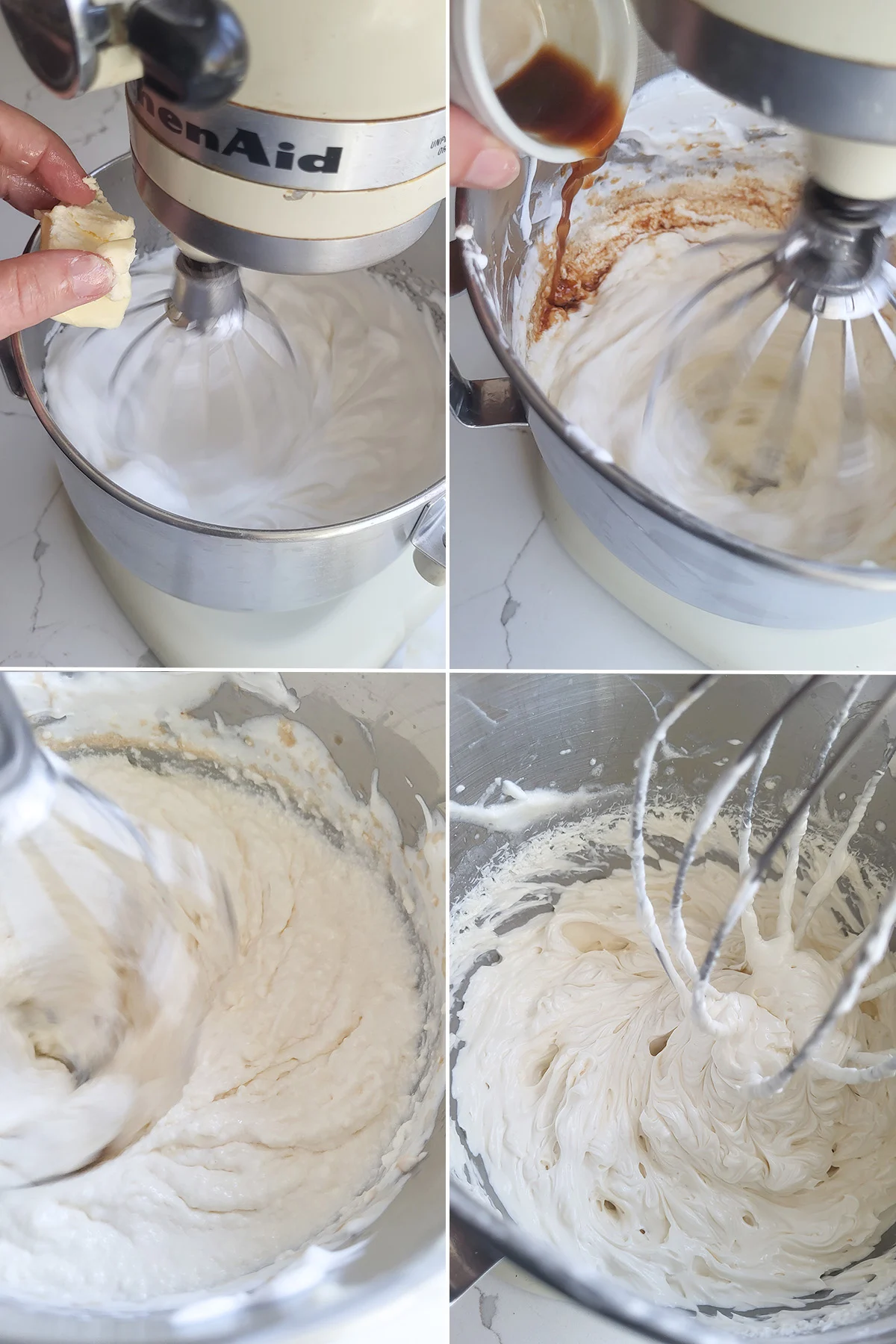
- Add the room temperature butter a tablespoon at a time.
- Add the vanilla.
- The buttercream may look a bit curdled after adding the vanilla.
- Keep whipping until the buttercream is silky smooth and airy. Use immediately or keep at room temperature until ready to use (up to 1 day).
How to Store Italian Meringue Buttercream.
Because there is relatively low moisture in the buttercream, and high sugar content, Italian Meringue Buttercream can be held at cool room temperature for up to a day. After 1 day the buttercream should be refrigerated for 3-4 days or frozen for up to a month.
Proper syrup temperature is important for a silky smooth Italian Meringue Buttercream
This is a fairly standard Italian Meringue Buttercream recipe except for the temperature of the sugar syrup. A lot of recipes have you boil the syrup well into the firm ball stage (248°F), but I find this makes a buttercream with a texture that is too tight and marshmallow-y.
I like to boil the syrup to the softball stage (235°-240°F) for a slightly softer buttercream that whips to a little lighter.
How to fix Italian Meringue Buttercream
- If you’re working in a warm kitchen and your buttercream is a little too soft you can refrigerate it briefly and then re-whip it until it’s light and fluffy.
- If your buttercream is a little too cold you can warm the bowl and then whip it until it’s light and fluffy.
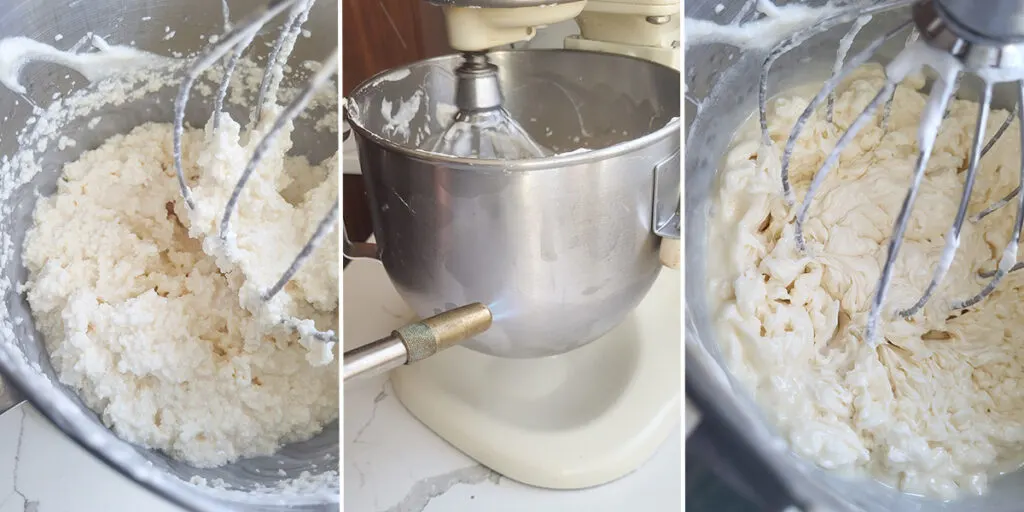
- To rewhip cold Italian Meringue Buttercream first bring it to room temperature. When you start whipping the IMB it may separate the look curdled.
- Use a blow torch or a bowl of warm water to warm the sides of the bowl as the buttercream whips.
- You’ll see the edges soften and and buttercream will come back together. Whip until the buttercream is silky smooth.
Pastry Chef tips for making perfect Italian Meringue Buttercream:
- If the meringue and/or the butter are too warm when they’re combined the buttercream will break down. If the buttercream becomes soupy and grainy the meringue has broken down and the buttercream can’t be fixed.
- If the butter is too cold when it’s added to the cooled meringue you’ll end up with lumps of butter that can’t be whipped out. Make sure the butter is soft and pliable, but not at all greasy or melted. The best temperature for the butter is about 70°F.
- Any extra buttercream can be double-wrapped in plastic (so it doesn’t pick up any off flavors) and frozen for a month. Bring it back to room temperature and then re-whip.
- The only limit to the flavors you can make with this buttercream is your imagination. You can add melted chocolate, lemon curd and/or lemon extract, orange zest, raspberry puree, instant coffee, whatever you can think of to create your favorite buttercream flavor.
Swiss Meringue Buttercream is very similar to IMBC except that you warm the sugar and eggs over a water bath rather than making a sugar syrup.
If you want a buttercream that is just as light and airy as a meringue buttercream, but with a slightly richer flavor and color, try making classic French Buttercream. It’s made with egg yolks instead of egg whites.
Now that you’ve made this recipe what should you do with the extra yolks? Check out this collection of recipes that use extra yolks for some great ideas.
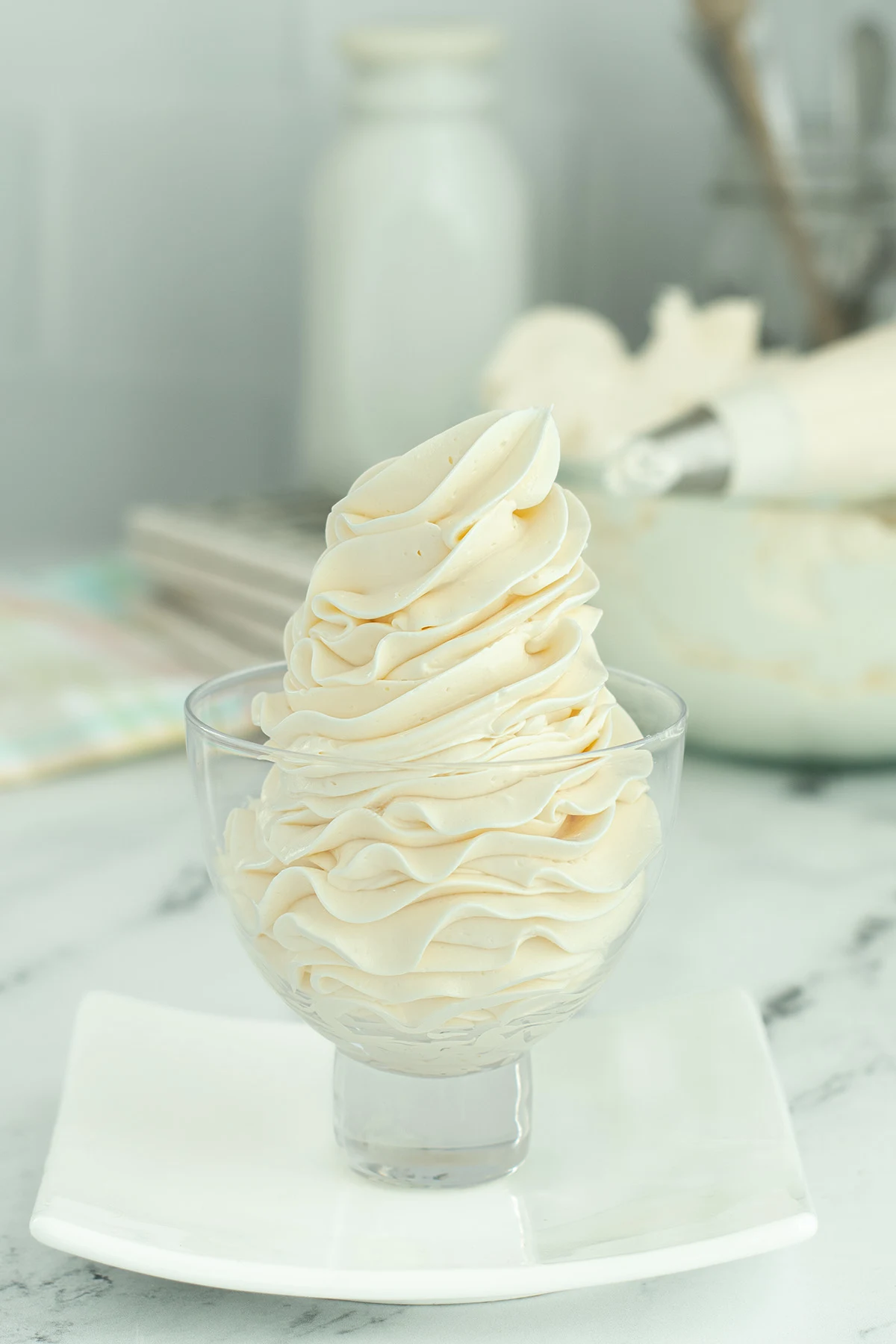
If you love this recipe as much as I do, please consider leaving a 5-star review.
Italian Meringue Buttercream Recipe
Ingredients
- 2 ounces water (¼ cup)
- 8 ounces granulated sugar (1 cup, divided)
- 5 egg whites (room temperature)
- ¼ teaspoon table salt
- 1 pound unsalted butter (room temperature, cut into 16 pieces)
- 1 tablespoon vanilla extract
- Other flavorings to taste
Instructions
- Combine 2 ounces water with 3/4 cup (6oz) granulated sugar in a small saucepan. Cook the sugar syrup on medium high heat, stirring, until the sugar is melted. Once the syrup begins to boil do not stir the syrup. Allow it to cook to 235°-240°F (soft ball stage).
- While the syrup is boiling, whip 5 egg whites on medium high speed. When the whites are at soft peak reduce the mixer to medium low and slowly add the remaining 1/4 cup of sugar and ¼ teaspoon table salt. Increase the speed to medium high and whip to full peak.
- As soon as the syrup is at the correct temperature, remove the pan from the heat. With the mixer running on medium low, pour the hot syrup in a steady stream between the edge of the bowl and the whisk. Increase the speed to medium high and continue whisking until the whites are cooled to about 80°F.
- When the whites have cooled, with the mixer running on medium, add 1 pound unsalted butter one piece at a time. Add 1 tablespoon vanilla extract and increase the speed to medium high and whip until the buttercream comes together.
- Store at room temperature for up to 1 day then refrigerate or freeze.
Would you like to save this recipe?
Equipment
As an Amazon Associate and member of other affiliate programs, I earn from qualifying purchases.


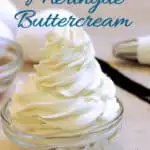
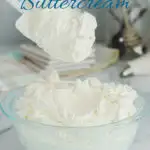

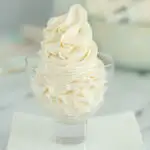






This is an excellent recipe that I’ve used many times, so thank you. Have you ever made a honey-flavored buttercream? I considered using honey to replace some of the water and sugar in the syrup, but I was concerned the different sugars in the honey would affect the consistency of both the syrup (wouldn’t reach soft ball stage) and the end result. Any help would be appreciated. Thanks again.
I haven’t tried using honey. A quick google search led me to this discussion on a beekeeping forum. Seems that, as you suspected, the honey wouldn’t behave as table sugar does in a syrup. The great Rose Levy Beranbaum has a recipe for honey buttercream in one of my favorite baking books of all time, The Cake Bible. That is a yolk based buttercream and she just replaces all the sugar and water with honey which has been brought up to the boiling point. Not sure if that would work with a meringue buttercream. What you can try is to use the honey as a flavoring. I add 2 tablespoons of molasses to this buttercream to make a “brown sugar” buttercream. It works really well. Of course, molasses has a much stronger flavor than honey, but I think it’s worth a try. This buttercream can take a surprising amount of liquid. Start with 2T and see if you get the flavor you like. If you want a stronger flavor try adding a little more at a time and keep an eye on the texture. Let me know if you try it how it works out.
Thanks for the suggestion. I ended up using 5 Tbs of honey and it actually could have been more strongly flavored. The buttercream easily withstood the addition of the honey with no texture change. Even able to pipe roses.
Great. That’s good to know.
Wow! Never made this before and I am quite a novice in the kitchen but it came out brilliantly! I found it really useful that all the different temps were added – I kept a probe thermo on me at and I think that really made the difference. Also great to have the ‘things that can go wrong’ advice. I also used a pre-prepped bag of ice to put under my mixing bowl to cool the whites and that really worked well. Thanks very much!
Great idea to use a bag of ice to cool the whites.
Hello thank you for this recipe! I live in Houston tx and it’s often really humid. Is this recipe really firm? Or what do you recommend me?
I’ve made this recipe in every type of weather with no problem.
Fixing a cold butter buttercream is totally do-able!
I came across small lumps of butter in my buttercream and I looked at it in total disappointment thinking, wow I’m gonna have to make this again.
Then I thought back to when in class, we were making buttercream and mine curdled, chef told me to warm up the bottom and re whip. I did exactly that and now I have a beautifully whipped buttercream!
SO, if you have cold lumps of butter in your buttercream, warm the bowl a bit and try to re whip, patience is very very important!
Thanks for the great recipe!!!
This is an excellent recipe! I’ve made this recipe several times now and it always turns out delicious and buttery. I’ve used it to fill cakes, ice cakes and cupcakes. I have a batch in the freezer that I will use to fill macarons.
Thanks! It freezes beautifully too!